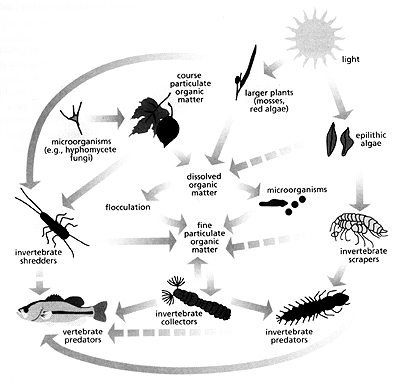 |
 |
Biological Community
The morphometric and physical properties of a stream determine the availability of suitable habitat for biota. The unidirectional flow of water is one of the most important factors controlling survival in rivers. River-adapted organisms must have strategies to protect themselves from being flushed downstream. Other factors that determine the suitability of habitat are flow regime, water quality, temperature, sunlight, oxygen, food, and protection from predators.
The organisms in an ecosystem are interconnected to form a food web. The food relationships commonly observed among stream biota are shown in Figure 1.8. In rivers, the primary producers that compose the base of the food web include aquatic plants (macrophytes) and algae. Some types of algae, known as periphyton, attach to surfaces in the stream channel, whereas others, known as phytoplankton, are suspended in the water. Primary producers use energy from sunlight to turn dissolved inorganic nutrients (nitrogen, phosphorus, carbon) into organic matter through photosynthesis. Organisms that feed on this plant tissue convert it to animal tissue, waste and energy. Decomposition of organic materials occurs as other organisms break down dead plant and animal tissue and wastes.

Figure 1.8 Stream Biota. Reprinted with permission of the Federal Interagency Stream Restoration Working Group (1998).
The relationship between the rate of primary production and the rate of decomposition influences the availability of habitat for stream biota. If primary production exceeds decomposition, the stream reach is described as autotrophic. If decomposition exceeds primary production, as occurs in most streams, the stream reach is described as heterotrophic. Most of the organic matter for the food web in heterotrophic stream reaches comes from external sources, such as the leaves of riparian trees and soil organic matter.
Primary producers that anchor themselves to the bottom substrate, such as large aquatic plants and attached algae, are more abundant in stream reaches where sunlight is unobstructed by riparian shade or suspended sediment. These producers tend to thrive in mid-reaches with substrates composed of coarser materials, ranging from sands to gravels. Other primary producers, such as phytoplankton, remain suspended in water and prefer slow-moving flow conditions found near stream banks, behind obstructions, and in the backwaters of lowland rivers.
Organisms that feed directly on non-living coarse particulate organic matter (detritus) include bacteria, fungi, and some invertebrates known as shredders. These organisms proliferate in forested headwater streams, where detritus is plentiful and where the substrate allows for attachment. Other organisms, such as scrapers and grazers, feed directly on primary producers and thrive where the plants they feed on are most abundant. Both shredders and scrapers produce fine particulate organic material, bits of shredded and partly decomposed detritus and wastes. Invertebrates that feed on fine particulate organic material (collectors) flourish in lowland reaches where they collect food supplied by upstream activities. Fish and other vertebrate predators feed on collectors, shredders and other invertebrate predators.
Fish species have adapted to different stream habitats over time by modifying their forms, habits, and reproductive strategies. For example, the small agile bodies of fish in high-gradient upland streams allow them to accelerate quickly and move through the swift and rolling flow of these streams. In response to seasonal variability of water levels, from periods of flood to periods of low or no flow, some species mature rapidly and have short life spans. They usually require higher oxygen content and lower temperatures (<20°C) than downstream species. Low gradient floodplain rivers provide a greater variety of environments and therefore are populated by a wider variety of organisms. Fish in these rivers may be larger and are tolerant of wider ranges of temperature, higher temperatures, and lower oxygen concentrations.
For some fish, upland streams provide habitat for spawning and for young, while the lowland river is home to adults. In floodplain rivers where seasonal flood pulses provide a full range of flowing to still-water habitats, fish use shallow, seasonally flooded pools for reproduction and maturation.